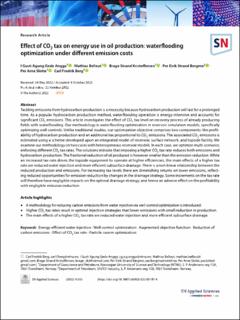| dc.contributor.author | Angga, I Gusti Agung Gede | |
| dc.contributor.author | Bellout, Mathias | |
| dc.contributor.author | Kristoffersen, Brage Strand | |
| dc.contributor.author | Bergmo, Per Eirik Strand | |
| dc.contributor.author | Slotte, Per Arne | |
| dc.contributor.author | Berg, Carl Fredrik | |
| dc.date.accessioned | 2023-01-09T09:38:59Z | |
| dc.date.available | 2023-01-09T09:38:59Z | |
| dc.date.created | 2022-11-15T14:16:31Z | |
| dc.date.issued | 2022 | |
| dc.identifier.citation | SN Applied Sciences. 2022, 4, 26. | en_US |
| dc.identifier.issn | 2523-3963 | |
| dc.identifier.uri | https://hdl.handle.net/11250/3041830 | |
| dc.description.abstract | Tackling emissions from hydrocarbon production is a necessity because hydrocarbon production will last for a prolonged time. As a popular hydrocarbon production method, waterflooding operation is energy-intensive and accounts for significant CO2 emissions. This article investigates the effect of CO2 tax level on recovery process of already producing fields with waterflooding. Our methodology is waterflooding optimization in reservoir simulation models, specifically optimizing well-controls. Unlike traditional studies, our optimization objective comprises two components: the profitability of hydrocarbon production and an additional tax proportional to CO2 emissions. The associated CO2 emissions is estimated using a scheme developed upon an integrated model of reservoir, surface network, and topside facility. We examine our methodology on two cases with heterogeneous reservoir models. In each case, we optimize multi-scenarios enforcing different CO2 tax rates. The solutions indicate that imposing a higher CO2 tax rate reduces both emissions and hydrocarbon production. The fractional reduction of oil produced is however smaller than the emission reduction. While an increased tax rate drives the topside equipment to operate at higher efficiencies, the main effects of a higher tax rate are reduced water injection and more efficient subsurface drainage. There is a non-linear relationship between the reduced production and emissions. For increasing tax levels there are diminishing returns on lower emissions, reflecting reduced opportunities for emission reduction by changes in the drainage strategy. Some increments on the tax rate will therefore have negligible impacts on the optimal drainage strategy, and hence an adverse effect on the profitability with negligible emission reduction. | en_US |
| dc.language.iso | eng | en_US |
| dc.publisher | Springer | en_US |
| dc.rights | Navngivelse 4.0 Internasjonal | * |
| dc.rights.uri | http://creativecommons.org/licenses/by/4.0/deed.no | * |
| dc.subject | Particle swarm optimization | en_US |
| dc.subject | Effect of CO2 tax rate | en_US |
| dc.subject | Reduction of carbon emissions | en_US |
| dc.subject | Augmented objective function | en_US |
| dc.subject | Well-control optimization | en_US |
| dc.subject | Energy-effcient water injection | en_US |
| dc.title | Effect of CO2 tax on energy use in oil production: waterflooding optimization under different emission costs | en_US |
| dc.title.alternative | Effect of CO2 tax on energy use in oil production: waterflooding optimization under different emission costs | en_US |
| dc.type | Peer reviewed | en_US |
| dc.type | Journal article | en_US |
| dc.description.version | publishedVersion | en_US |
| dc.rights.holder | © The Author(s) 2022 | en_US |
| dc.source.pagenumber | 26 | en_US |
| dc.source.volume | 4 | en_US |
| dc.source.journal | SN Applied Sciences | en_US |
| dc.identifier.doi | 10.1007/s42452-022-05197-4 | |
| dc.identifier.cristin | 2074343 | |
| dc.relation.project | Norges forskningsråd: 296207 | en_US |
| cristin.ispublished | true | |
| cristin.fulltext | original | |
| cristin.qualitycode | 1 | |

